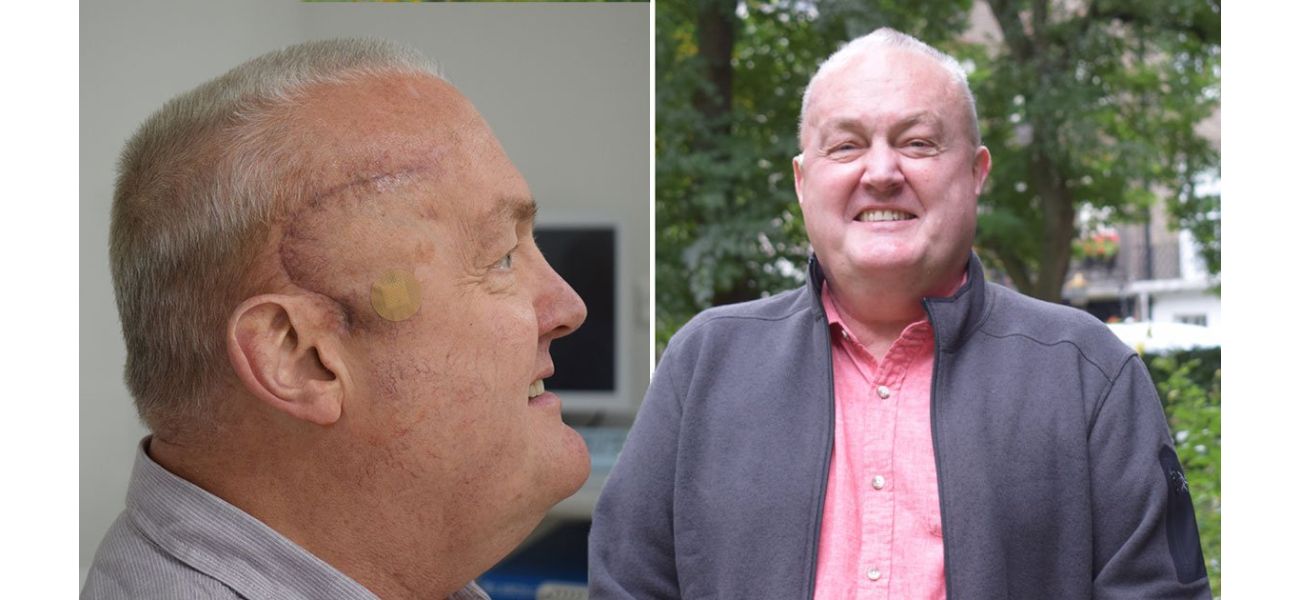New treatment shrinks man's deadly brain tumour by half, bringing hope to patients.
New research on a deadly brain cancer is offering hope to those with glioblastoma, typically fatal within 18 months.
October 29th 2024.

62-year-old Paul Read has been through a lot over the past year. In December of last year, he was diagnosed with glioblastoma, an aggressive form of brain cancer that typically has a grim prognosis of only 18 months. But thanks to new studies and clinical trials, there is now hope for people like Paul.
Paul was the first patient to enroll in the University College London Hospitals NHS Foundation Trust trial. He was open to trying new treatments, saying he had "nothing to lose and everything to hope for." The trial involves a small amount of radiation being injected directly into the cancer, with the goal of killing cancer cells while sparing healthy tissue. Doctors are hopeful that this method could even completely eradicate the disease.
After surgery to remove as much of the tumor as possible, Paul had a small medical device called an Ommaya reservoir implanted under his scalp. This device is connected to the tumor via a tube and allows for a radioactive drug to be injected directly into the tumor every four to six weeks. Paul has had great results from the trial so far and has not experienced any major side effects. He sees the trial as a lifeline and is happy to participate, even if it doesn't directly benefit him.
The trial is currently treating one patient a month in the first phase, but there are plans to expand to include more patients. Dr. Paul Mulholland, the chief investigator, is optimistic that one day they will be able to cure this type of cancer because it only occurs in one location in the brain and does not typically spread to other parts of the body.
There has also been another major development in the diagnosis and monitoring of glioblastoma. A new type of scan called the "immuno-PET imaging technique" has been developed by scientists from The Institute of Cancer Research, London. This scan measures levels of a protein called PD-L1, which is found in rapidly progressing glioblastomas. Blocking this protein can "kick-start" the body's immune system to fight the cancer.
To measure the levels of PD-L1, scientists have developed a "radiotracer" that binds to the protein, making it possible to measure its levels in patients. The tracer was tested on eight patients in Poland who were newly diagnosed with glioblastoma. The scans showed that the tracer successfully binds to PD-L1 positive cells within the tumor and throughout the body.
Three of the five patients who received the tracer and the drug pembrolizumab before surgery have seen their cancer stabilize and not grow any further. The ongoing clinical trial aims to recruit 36 patients to see if this treatment is effective. Researchers are also looking into using the PET scan to monitor progress and adjust treatment as needed.
Dr. Gabriela Kramer-Marek, a group leader in preclinical molecular imaging at The ICR, explains that this new scan allows doctors to predict a patient's response to treatment and make adjustments as needed, without the need for a pre-surgery biopsy. This personalized approach based on the unique characteristics of each patient's tumor could lead to more effective treatment.
Professor Kristian Helin, the chief executive of The ICR, emphasizes the urgency for new approaches to monitor and treat glioblastoma. He notes that although immunotherapies have shown promise in other types of cancer, progress has been stalled by the lack of a biomarker test to show who might benefit from them. This new scan could be a game-changer in the treatment of glioblastoma.
Dr. Simon Newman, the chief scientific officer at The Brain Tumour Charity, is encouraged by the findings of this study and hopes to see similar advancements in brain tumor treatment. He believes that immunotherapies have shown progress in other types of cancer and is pleased to see progress in this area. He looks forward to following this work as it advances to larger clinical trials.
Paul was the first patient to enroll in the University College London Hospitals NHS Foundation Trust trial. He was open to trying new treatments, saying he had "nothing to lose and everything to hope for." The trial involves a small amount of radiation being injected directly into the cancer, with the goal of killing cancer cells while sparing healthy tissue. Doctors are hopeful that this method could even completely eradicate the disease.
After surgery to remove as much of the tumor as possible, Paul had a small medical device called an Ommaya reservoir implanted under his scalp. This device is connected to the tumor via a tube and allows for a radioactive drug to be injected directly into the tumor every four to six weeks. Paul has had great results from the trial so far and has not experienced any major side effects. He sees the trial as a lifeline and is happy to participate, even if it doesn't directly benefit him.
The trial is currently treating one patient a month in the first phase, but there are plans to expand to include more patients. Dr. Paul Mulholland, the chief investigator, is optimistic that one day they will be able to cure this type of cancer because it only occurs in one location in the brain and does not typically spread to other parts of the body.
There has also been another major development in the diagnosis and monitoring of glioblastoma. A new type of scan called the "immuno-PET imaging technique" has been developed by scientists from The Institute of Cancer Research, London. This scan measures levels of a protein called PD-L1, which is found in rapidly progressing glioblastomas. Blocking this protein can "kick-start" the body's immune system to fight the cancer.
To measure the levels of PD-L1, scientists have developed a "radiotracer" that binds to the protein, making it possible to measure its levels in patients. The tracer was tested on eight patients in Poland who were newly diagnosed with glioblastoma. The scans showed that the tracer successfully binds to PD-L1 positive cells within the tumor and throughout the body.
Three of the five patients who received the tracer and the drug pembrolizumab before surgery have seen their cancer stabilize and not grow any further. The ongoing clinical trial aims to recruit 36 patients to see if this treatment is effective. Researchers are also looking into using the PET scan to monitor progress and adjust treatment as needed.
Dr. Gabriela Kramer-Marek, a group leader in preclinical molecular imaging at The ICR, explains that this new scan allows doctors to predict a patient's response to treatment and make adjustments as needed, without the need for a pre-surgery biopsy. This personalized approach based on the unique characteristics of each patient's tumor could lead to more effective treatment.
Professor Kristian Helin, the chief executive of The ICR, emphasizes the urgency for new approaches to monitor and treat glioblastoma. He notes that although immunotherapies have shown promise in other types of cancer, progress has been stalled by the lack of a biomarker test to show who might benefit from them. This new scan could be a game-changer in the treatment of glioblastoma.
Dr. Simon Newman, the chief scientific officer at The Brain Tumour Charity, is encouraged by the findings of this study and hopes to see similar advancements in brain tumor treatment. He believes that immunotherapies have shown progress in other types of cancer and is pleased to see progress in this area. He looks forward to following this work as it advances to larger clinical trials.
[This article has been trending online recently and has been generated with AI. Your feed is customized.]
[Generative AI is experimental.]
0
0
Submit Comment





